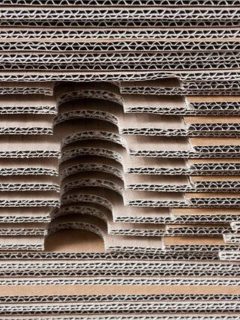Transporting works of art, especially contemporary works of art, is a task that requires special attention and precision. Every work of art, regardless of its artistic and material value, requires appropriate protection against damage that may occur during transport. What packaging should be selected for this purpose?
How do you protect works of art from transport?
Wondering how to pack a painting for shipment? Securing works of art before transport is a key step to protect them from mechanical damage and environmental influences. Paintings and other works of art should be carefully packed in specialised protective materials such as bubble wrap, foam or soft fabrics to minimise the risk of scratches and shocks.
Delicate objects are often placed in dedicated transport boxes that are tailored to their dimensions and specific characteristics.
In addition, the use of appropriate stiffeners and fillings in the boxes helps to prevent the artwork from shifting during transport, making the transport safer. Therefore, in order to ensure the safety of the items being shipped, it is important to pack them for shipment in a robust way, without sparing on the quality and quantity of the materials used to pack and secure the item being shipped.
It is also crucial to minimise, or preferably eliminate, the possibility of the item moving freely within the packaging. Placing appropriate markings – informative labels and warning labels for transporting fragile items – will further protect the artwork in transit.
What materials to choose for shipping artworks?
Choosing the right materials for packing artworks is crucial to ensure their safety during transport. There are a number of specialised materials that help protect works of art from different types of damage.
- Bubble wrap – is flexible and easily conforms to the shape of the item being packed, making it a versatile solution for protecting different types of artwork.
- Polyethylene foams – are available in a variety of densities and thicknesses, allowing for a perfect match to the specific needs of the object being packaged. Polyethylene foams provide excellent shock and impact protection and also stabilise the artwork inside the packaging, minimising the risk of shifting during transport.
- Soft fabrics – used to protect the surface of artworks from direct contact with other packaging materials. These fabrics, such as cotton or flannel, are soft and do not cause scratches or damage to the surface of the artwork. Soft fabrics are often used as a first layer of protection, especially for paintings and sculptures.
- Transport cases – provide maximum mechanical protection and stability during transport. Transport boxes are often reinforced and equipped with additional stiffening and cushioning systems, making them ideal for transporting valuable and fragile works of art.
- Cartons and corrugated cardboard – often used as an extra layer of protection around artworks packed in bubble wrap or polyurethane foam. Corrugated cardboard provides additional cushioning and shock protection. It is also a material that is easy to mould and fit to the shape of the object being packaged.
What about shipping artwork abroad?
Sending a painting abroad differs from domestic shipping in several respects. First of all, international shipping requires extra security and care to meet customs and tax requirements and to ensure safety during the longer journey.
The process begins with careful packing of the image – using high-quality protective materials such as bubble wrap and foam, and sturdy packaging or shipping crates to protect against damage and shock. It is also crucial to choose a professional courier company that is experienced in transporting artworks and offers tracking services and full insurance.
Compared to domestic shipping, international shipping also requires additional documentation, such as certificates of authenticity and export permits, to comply with customs regulations. It is also worth remembering to research the import regulations for artworks in the destination country to avoid customs clearance issues.
Read also: How to pack a parcel for shipping? 4 rules for safe packing.
How to pack artworks? Summary!
The best packaging for transporting contemporary art is that which offers maximum protection against mechanical damage and environmental influences. Bubble films and polyurethane foams effectively absorb shocks and protect against scratches, while soft fabrics protect the surfaces of delicate objects. Dedicated transport boxes, on the other hand, tailored to the dimensions and specific characteristics of the work, offer the highest level of mechanical protection. In addition, it is worth remembering about warning signs and choosing a professional courier company experienced in transporting works of art.














